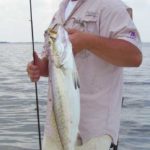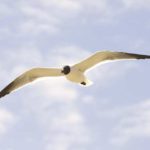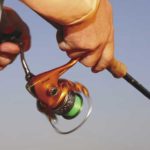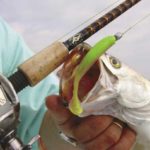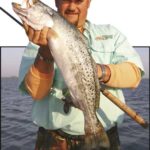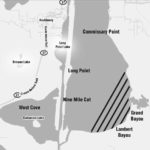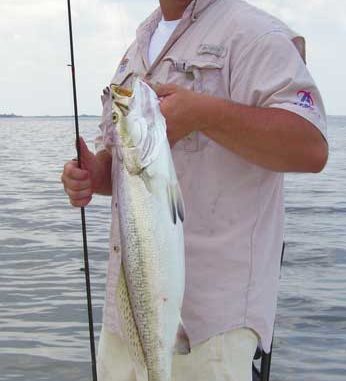
This is the month when trophy trout go crazy on Calcasieu Lake.
Size matters. If you don’t think so, stand at any of the number of boat ramps around Calcasieu Lake this month and ask anglers what they’re going after. I’ll bet you a dollar against a doughnut most of them will hold up their arms with hands spread wide and affirm, “We affa dem big trout.”
For many of these anglers, this will be their first trip to Southwest Louisiana’s most popular speckled trout hole since last fall, and what many of them might not realize is that the die-hard anglers and charter captains around the lake have been catching “dem big trout” since March.
What separates the weekend warriors from the diehards and captains is that those who stay on the lake year round don’t mind battling the 20-m.p.h. wind that shreds the open water from north to south and east to west — conditions that force the sane among us to keep our boats in their sheds.
Jeremy Waltrip teeters somewhere between sanity and psychosis. His desire to catch trout leads this seven-on-and-seven-off Jennings angler to spend nearly every one of his seven days at home at his favorite lake. His work schedule means he can’t be picky about which days he fishes. That’s why he loves to see May roll around.
“Man, I sit out there on the rig and read all the reports on louisianasportsman.com about how great the fishing is at Calcasieu and how calm the winds are,” said Waltrip. “Then I come in and all I get are gale-force winds and tough fishing. And you know my first day back out on the rig is when everything gets back to normal.”
Normalcy makes its way to Calcasieu Lake some time by the end of April, and May is as close to smooth sailing as one will find along the coast of Louisiana until the dog days of summer set in.
“I think the best thing about May at Calcasieu is that it’s easier to consistently catch limits of solid fish ranging from 2 to 4 pounds,” Waltrip said. “There’s still the opportunity to catch a big fish — 5 to 6 pounds — but this is the time to catch lots of quality trout before the school trout set in for the summer.”
Even though many anglers overlook the consistent catches of quality trout while they search out the super-sized specks, Capt. Erik Rue with Calcasieu Charter Service believes they may be justified in their efforts.
He knows Joe Angler has a better chance of catching a bunch of fish during May, but he also knows that what gets everybody excited is the big trout that tempt many to the point of obsession.
“Here, I think we always have the potential for trophy trout,” Rue said. “We go through different periods where we catch the schoolies for a while, which makes us think the potential for a trophy isn’t present. But the availability of big trout is here most of the year. It’s just a matter of how hard you want to work for them.
“Obviously, they seem to be more plentiful during April, May and June, and I would say the peak month for most anglers is May. But it’s hard to put a rule on when we catch trophy trout because we can go down to the jetties in the dead of summer and catch 3- to 5-pound fish down there with an occasional big one.”
The opportunity to consistently catch limits of quality trout coupled with the peak availability of trophy trout means Waltrip and Rue won’t be the only ones on the lake this month.
While it might not reach summer levels, the fishing pressure on Calcasieu Lake during May means anglers must know where to go and what to throw to stay in the mix. And it also doesn’t hurt to understand how to counteract the additional boats.
Both anglers agree that the most productive section of the lake during May is down south, especially if the tide is not that strong because this is the section that cleans up the fastest after heavy rains. Heavy rains also tend to push fish down from the northern half of the lake as the salt line recedes back toward the Gulf.
“We’ve learned that the fish bite first down the lake because of the way the water cycles,” Rue explained. “The only thing that might change that, the ship channel helps push clean water to the very top of the lake, which can turn on Turner’s Bay, but the southern end and the southeast corner are most popular because our prevailing winds are typically out of the south this time of year. Those shorelines are more protected and the water is saltier. There are a lot of fish down there during this time of year.”
Rue made sure to point out West Cove as being a popular spot for trophy trout during May. This shallow area is almost like a lake unto itself with just a small entry way off the west edge of the ship channel at the south of Calcasieu. Big trout seem to stack up in this area early, but they tend to move out to the main lake as the water gets hotter.
“One of the big variables that determines where our trout are going to be in May is how much rain we got during the spring,” Rue said. “If we don’t get a lot of rain, fish can scatter throughout the lake more because the salt water will move farther to the north. If we do get a lot of rain, which he have had this year, they concentrate near the southern shores and in West Cove.”
Rue and Waltrip focus mainly on the stretch of Calcasieu from Lambert Bayou in the far southeastern corner of the lake up to Commissary Point. This stretch has several oyster reefs that anglers can see marked on most any of the Calcasieu maps.
On the western side, which can be extremely productive for trophy trout as long as the wind doesn’t blow too hard, Waltrip pointed out that the reefs from Long Point down toward the Washout and Nine Mile tend to concentrate bait and big trout on the edges of the shells. These areas are especially good because so much bait comes into the lake through the ship channel, and this area offers the first openings to the main lake.
Without this bait, Rue believes Calcasieu Lake’s reputation would be dramatically different. He feels the key to catching trophy trout is to stay around the bait and to follow the bait if it moves.
“If you’re looking to catch a big trout,” he said, “you’ll do best if you get in those big masses of mullet down around the south shoreline over one of the reefs, and throw a bait conducive to catching a big trout — topwater, a Sand Eel, whatever big trout bait you prefer.”
Timing the big trout can be a tricky endeavor, though. Rue has found that something clicks with the full moon in May that creates great fishing immediately after this spawning cycle. Before the full moon, he finds the trout to be somewhat finicky.
“By the end of May, we don’t really catch that many heavy, heavy fish,” he explained. “It’s not that they are smaller fish because you’ll still catch 26-inch trout. It’s that as a percentage, if you catch 10 of them before the moon, they’ll all be heavy. If you catch those same 10 after the moon, 30 percent of them will be heavy because 70 percent of them will be spawned out.”
Even though big trout can be targeted at Calcasieu Lake during May, perhaps the better plan for most anglers is to just go fishing and let the big trout happen naturally rather than trying to force them to bite. Anglers can fill coolers with the 2- to 4-pound fish, and if they happen on to a sow trout, so much the better.
This is the way Waltrip approaches the lake during May, and he feels the thing that most anglers enjoy about fishing Calcasieu this time of year is the opportunity to exploit the topwater bite for the first hour or two of the morning.
“In May, you ought to be able to get your limits as long as the weather permits,” he said. “Basically, anything but high winds is OK. Even if it’s raining or cloudy, as long as the wind isn’t much over 10 m.p.h., you can go out there and get on the reefs and catch trout.”
Waltrip’s basic plan for May is to throw Zara Spooks and Top Dogs until approximately 9:30 or 10 a.m. He prefers chrome and mullet colors, and he begins with a fast retrieve, but he slows it down if dictated by the trout.
“I try to cover as much water as I can with it,” he said. “While I’m fishing it fast, though, I stay on the lookout for any movement on the surface, and I always make sure to throw to that. If the fish don’t eat it with a quick retrieve, I’ll start slowing it down, pausing it every now and then — anything to figure out how the fish want it that particular day.”
While Waltrip will stick with a topwater all day under overcast skies, he typically switches to a Norton Sand Eel Jr. when the topwater bite dies on a sunny day. He’ll continue to work the same reefs, but he also stays on the lookout for birds, which will be picking over the bait by this time of year.
“I like a glow/chartreuse eel if the water is pretty clear,” Waltrip said. “And I go to something like a margarita color or the LSU in stained water. If it’s really messed up, I’ll try the black/chartreuse eel. I rig the Sand Eel on a 1/4- or 3/8-ounce jighead for most conditions.”
Like figuring out the topwater bite, Waltrip lets the trout tell him how to fish his soft plastic. If he notices that fish are eating it as soon as it hits the water, that’s his clue to keep the bait high in the water and to jerk it back quickly. If the bites are coming on bottom, he slows down and bumps it over the oysters.
Waltrip and Rue usually don’t find themselves alone on any reef during May. Learning how to fish around other people is important if you want to stay on the bite while everybody else is cussing each other about intruding on their space.
“I just say give every man his space,” Waltrip said. “There is enough room out here for everybody to get some action. But if you don’t want to fight the crowd, I would suggest moving out to the edges of the reef.
“Typically what happens when lots of boats get on top of a reef is that the trout move out to the edges of it to escape the pressure. If you move out away from the crowd and try to find the edge of the pile, you’ll stay on the fish and keep catching them.”
Rue explained that anglers shouldn’t expect the trout to just abandon a reef because it has a few boats on top of it. He was always taught that the reefs are just gathering spots for bait, and that the food chain gathers around them. That’s why the fish are there, and that’s why the anglers are there. From plankton to humans, reefs concentrate the entire food chain.
“When there is a ton of bait in the lake like right before shrimp season or when there are a bunch of pogies in the lake, you might have a little harder time catching on the reefs because the fish can scatter out with the bait in open water,” he said. “But right now, when the bait is concentrated on the reefs, you can bet the trout — small and large — are on the reefs. So that’s where you should be if you want to catch fish.”
Contact Capt. Erik Rue at (337) 598-4700 or www.calcasieucharters.com.
